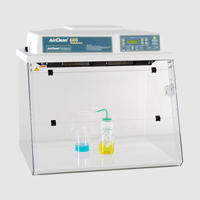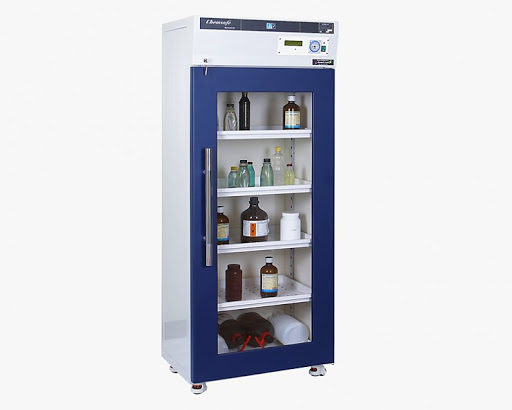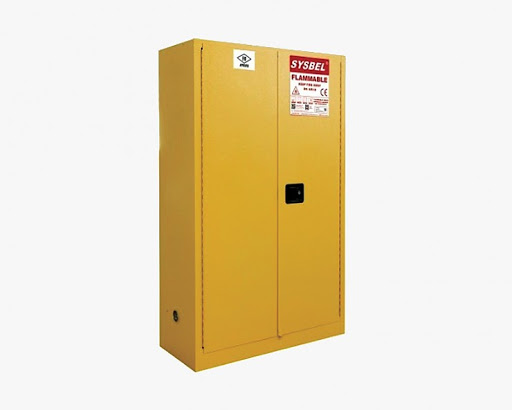- A researcher must conduct an experiment that generates toxic gas in a hood.



-
 Safety checkpoint
Safety checkpoint
A hood should be frequently checked if it is operated well. At least twice a year, its wind speed should be checked by using a gauge. Simply, attach a tissue paper on a hood window
and check if it is well sucked in. A hood should have a proper face velocity to effectively extract toxic substances.- - Recommended wind velocity fpm(feet per minute)
70~100 fpm: For general use (slight toxic materials) / 150 fpm: For special use (very toxic materials such as carcinogens) - - Tissue paper, etc. should not be in a hood. If it is sucked into the hood, it may block the airflow inside the hood and the hood may not work properly.
- - Reagents should not be stored in a hood. If there are many reagents in the hood, the air does not well flow inside the hood.
- - As the hood chassis does not protect people from strong explosions, before an experiment with a risk of the explosions is conducted, the researcher should install a safety shield inside the hood.
- - A hood is not a place where waste is stored. After experiments, clean the hood.
- - Recommended wind velocity fpm(feet per minute)

- 연구실에서 사용하는 화학물질의 노출로부터 연구자를 보호하기 위한 장비
-
 밀폐형시약장 사용, 관리, 주의사항들
밀폐형시약장 사용, 관리, 주의사항들
- - 밀폐형시약장에 화학물질을 보관할 경우 화학물질을 성상별로 분류하여 보관해야한다.
- - 실험에 필요한 화학물질은 소분하여 사용하고 화확물질은 담은 시약병들은 시약장에 보관한다.
- - 밀페형시약장 외 연구실에 화학물질을 방치하지 않는다.

- 연구실에서 사용하는 인화성 물질로 인한 화재 및 폭발 사고로부터 연구자를 보호하기 위한 장비
-
 인화성 물질 보관함 사용, 관리, 주의사항들
인화성 물질 보관함 사용, 관리, 주의사항들
- - 인화성 물질 보관함에는 인화성 물질만 보관한다.
- - 인화성 물질 보관함에는 80L 이하로 인화성 물질은 보관한다.
- - 인화성 물질은 필요한 만큼만 소분하여 사용하고 인화성물질을 담고있는 병 및 철캔은 인화성물질 보관함에 보관한다.
- A biological safety cabinet (BSC) is used to protect researchers from the particles or aerosols generated from laboratories that handle microorganism.
-
 Use of, management of, and precautionary measures for biological safety cabinets
Use of, management of, and precautionary measures for biological safety cabinets
- - A BSC is equipped with a High Efficiency Particle Arrestor (HEPA) filter.
- - As a HEPA filter cannot filter gaseous compounds like organic vapors and these organics easily block the filter, it should be inhibited to experiments with organic matters in a BSC.
- - A wind velocity to the outside should be well balanced with that from the outside to the experiment place.
- Ultraviolet rays and lasers are fatal to the eyes. A researcher must wear safety equipment and protective gears before exposing oneself to ultraviolet rays and lasers.
-
 Cautions when using ultraviolet rays and laser
Cautions when using ultraviolet rays and laser
- - In a laboratory where lasers are used, a laser sign should be attached. When using lasers, an indicator should be turned on.
- - A researcher should wear safety glasses to protect his/her eyes from the light with the wavelength used.
- - DO NOT look straight onto lasers.
- - Do not place an object that can reflect light on the path where the beam is passed.
- - Experimental equipment should be fully blocked so that ultraviolet rays are not scattered directly or by diffraction.
- - Do not expose your skin to ultraviolet rays.


